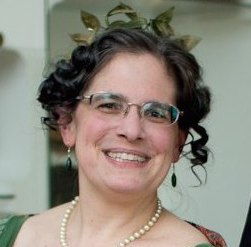Like the New Scotia Quadrille, the Aladdin Quadrille is one of several single-figure quadrilles found in the “New, Enlarged, & Complete Edition” of D. (David) Anderson’s Ball-Room Guide (Dundee, this edition undated but probably c1886). This is a simple, fun figure that would fit easily into a Scottish-themed ball.
Despite there being various quadrille sets called the Aladdin Quadrilles, Anderson doesn’t seem to have had any specific music in mind. He notes only that it can be danced in 2/4 or 6/8.
Aladdin Quadrille (8 bars introduction + 64 bars x4)
8b Introduction/honors (not repeated)
8b All promenade round
4b Ladies advance to the center and retire
4b Gentlemen advance to the center and retire
8b All set to partners and turn by the right hand
8b Head couples advance and retire, then half right and left
8b Side couples advance and retire, then half right and left
8b Grand chain half round to places
16b All waltz (in duple time) around (see performance notes below)
The figure is danced four times, with the head couples leading on the first and third iterations and the side couples leading on the second and fourth.
Reconstruction Notes
There is no eight-bar introduction for honors specified, but it’s standard for Anderson’s quadrilles.
The bars for each figure are given clearly except at the very end, where the half grand chain and waltz around appear to be given only sixteen bars total. Eight bars is a bit tight for all four couples to circle the set while turning, and as written the figure is a musically irritating (though not unheard of) fifty-six bars. I decided to assume that Anderson, who is generally terrible about listing bars for figures, neglected to note the eight bars for the grand chain and really meant the waltz-around to take a full sixteen bars.
Performance Notes
In my reconstruction of the New Scotia Quadrille, I talked extensively about Anderson’s particular quirks for quadrilles, notably:
- right and left is done without giving hands
- set to partner is a step-close-step-touch to the right and then to the left
- the turn after setting is by the right hand only
- I believe Anderson intended his quadrille figures to be walked rather than danced with some sort of chassé step, though I can’t entirely rule out the livelier footwork
I’m not going to repeat all the details; please see my earlier post for more discussion of these figures and Anderson’s style of bow and curtsey.
One figure found in Aladdin which is not in New Scotia is the waltz-around. I don’t believe this is meant to be 3/4-time waltz; I think he simply meant a turning dance, which could be a galop, polka, or, my preference, a standard valse à trois temps in duple time (“1&2” rhythm rather than “123”), perhaps done as a hop-waltz with a spring instead of a step on the first beat of every measure.
Another reconstruction
Interestingly, while the Aladdin Quadrille doesn’t seem to have become a standard part of the modern Scottish (RSCDS) dance repertoire, a teacher named Jimmie Hill recently reconstructed and taught it as part of a workshop in Dumfries. His reconstruction and notes may be found here (PDF). The figures are so simple that all reconstructions are going to be quite similar. He made the same decision I did about adding eight bars for the half grand chain rather than squeezing the waltz-around into eight. The differences in his reconstruction are: (1) “set twice”, meaning right-left-right-left, rather than Anderson’s longer movements, (2) a two-hand turn rather than Anderson’s specified right hand turn, and (3) switching to waltz music for the last sixteen bars. The first two differences are more modern style, which is a different effect than I strive for, and the third I simply disagree with, as there is no indication that Anderson intended this to be a medley dance or that there should be any change in the music. (Medley quadrille figures certainly did exist, but I don’t think this is one of them.)


Leave a Reply